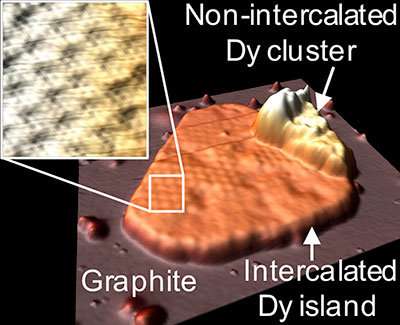Method of layering metals with the 2-D material may lead to brand new properties

Scientists at the U.S. Department of Energy's Ames Laboratory have discovered a new process to sheathe metal under a single layer of graphite which may lead to new and better-controlled properties for these types of materials.
Graphene—two-dimensional graphite—was first produced in 2004, and because electrons move rapidly along its surface, holds great promise as a useful material in applications as diverse as quantum computing, solar cells, catalysis, and sensing. In order for graphene to live up to that potential, fundamental discovery science at Ames Laboratory is working to master its assembly in combination with other materials—a tricky, delicate process performed in ultra-high vacuum lab environments at the atomic scale.
The researchers encapsulated dysprosium, a magnetic rare-earth metal, by bombarding the top layer of bulk graphite with ions to create defects on its surface, followed by high-temperature deposition of the metal. It resulted in "mesas" or islands of dysprosium underneath a single layer of graphene. The formations are significantly different than anything the Laboratory's two-dimensional materials experts have ever seen.
"It's well-known that certain metals can be embedded between bulk graphite layers," said Research Assistant Ann Lii-Rosales. "But these mesas form at the top graphite surface only, and they are pure metal composed of multilayers, which is a first. The combined properties of the metal plus graphene may be very different than other, previously produced materials. That's something we're exploring now."
The researchers were also able to achieve the same mesa-like formations with two transition metals, ruthenium and copper.
"That suggests we have a very adaptable recipe for producing this kind of surface material, which makes its discovery very exciting in terms of potential applications," said Pat Thiel, an Ames Laboratory scientist and Distinguished Professor of Chemistry and Materials Science and Engineering at Iowa State University. "If we can control the process so that we can deliberately pattern the formation of these little metal slabs, perhaps we can harness and control their magnetic and electronic properties."
The research is further discussed in the paper "Defect-mediated, thermally-activated encapsulation of metals at the surface of graphite," published in the journal Carbon.
More information: Yinghui Zhou et al. Defect-mediated, thermally-activated encapsulation of metals at the surface of graphite, Carbon (2017). DOI: 10.1016/j.carbon.2017.10.103
Journal information: Carbon
Provided by Ames Laboratory




















